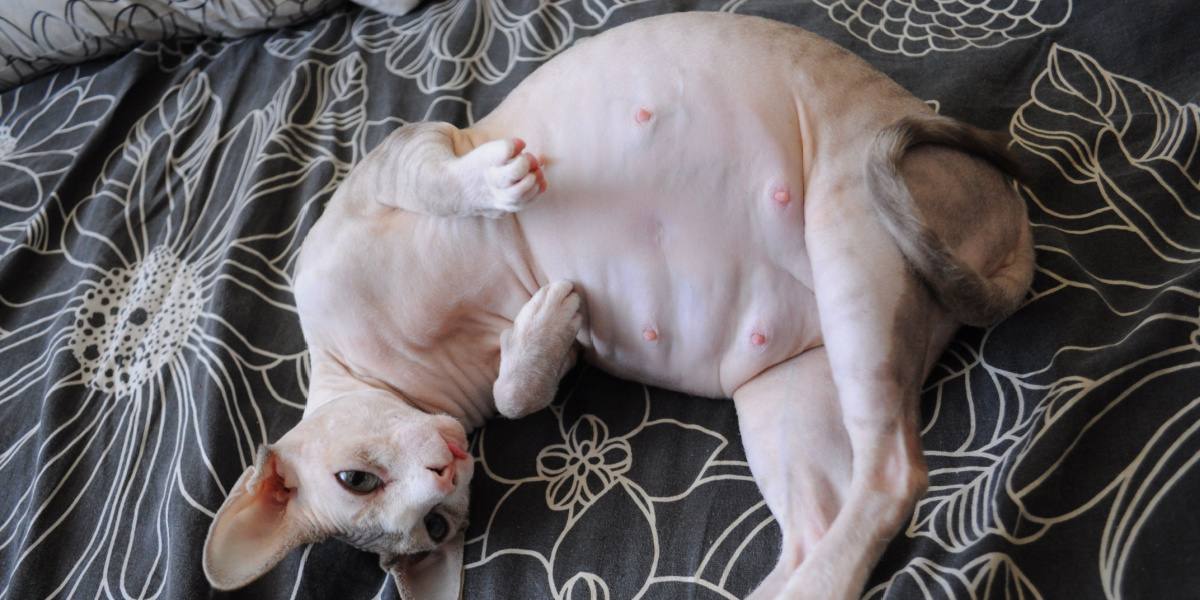
If you have a female cat and think she might be pregnant, it can be a time of many emotions, from excitement to overwhelm. Female cats come into heat (estrus) every few weeks between spring and fall, so a feline pregnancy is easy to come by.
Key Takeaways
Both male and female cats have multiple pairs of nipples, which are usually small, pale, and mostly hidden by fur.
In pregnancy, cats’ nipples turn red or dark pink, and get larger; other signs of pregnancy include an enlarged belly and behavioral changes.
Other conditions can cause nipple changes, such as estrus (heat), mastitis, and mammary cancer.
You can observe many signs that your pet is about to become a mother cat, including changes to the nipples, behavioral changes, and weight gain. However, changes to a cat’s mammary glands can also be symptoms of other health concerns. Read on to find out more about cats’ nipples, pregnancy, and more.
All About Cat Nipples
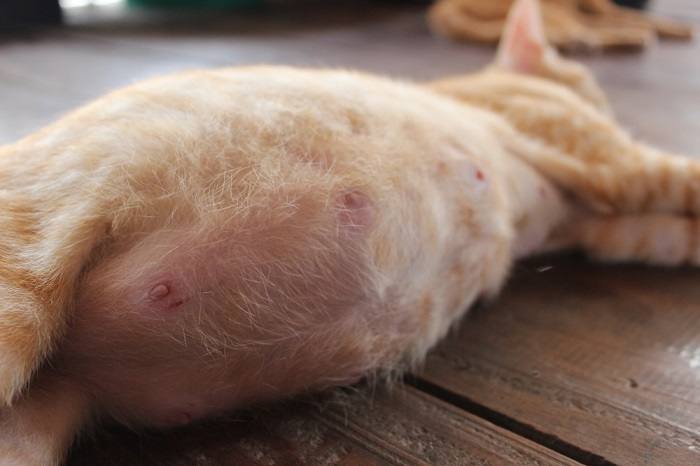
A cat’s multiple nipples are arranged so they can nurse all of their kittens simultaneously.
Most cats have either six or eight nipples, lined in pairs down their bellies. Occasionally, a cat might have more or less than this, or even an odd number of nipples. This pattern of mammary glands allows a litter of kittens to all nurse at the same time.
When females are not pregnant, their nipples are very small (almost like a little pimple) and often hidden by fur. You might see a small ring of hairless skin around each nipple. The nipples are pale, usually a similar color to the cat’s skin.
Do male cats have nipples? They certainly do—just as male humans do. Nipples are present on embryos before male or female sex organs develop, but in male cats, these nipples and mammary systems remain small and dormant for life.
Also Read: The Complete Feeding Guide From Kittens To Seniors
Nipple Changes In Pregnancy
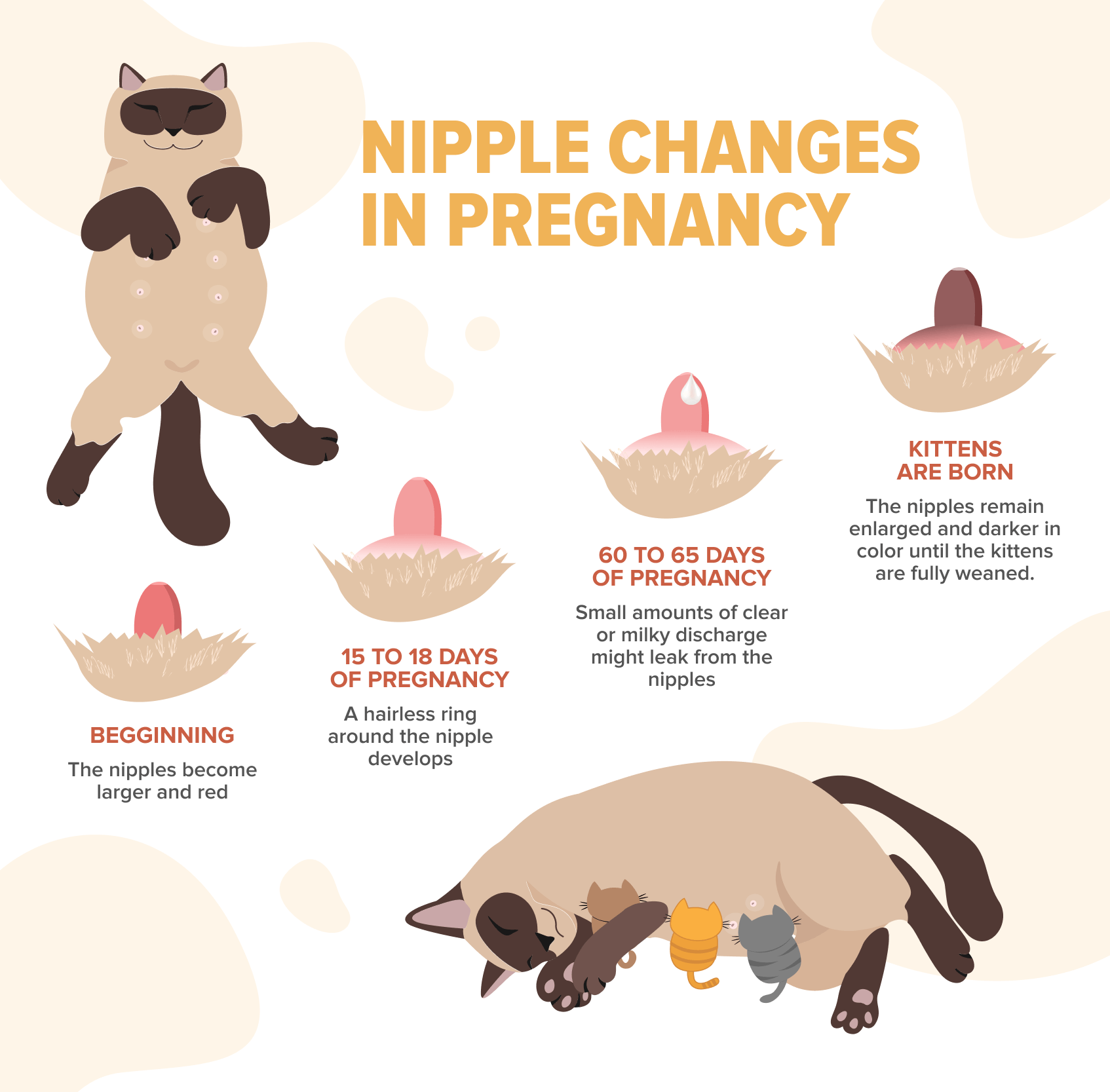
One of the most obvious signs of early pregnancy in felines is nipple changes. Around 15 to 18 days of pregnancy (shortly after the eggs implant), the nipples become larger and red. This is often referred to as “pinking up” and can be a very distinct change—the nipples might double or even triple in size.
A hairless ring around the nipple develops, which makes the nipples easier to find. The nipples and mammary system are beginning to prepare for lactation and nursing.
In late pregnancy, by around day 60 to 65, the nipples are surrounded by hairless skin and are prominent and very obvious, standing out from the enlarged abdomen. Small amounts of clear or milky discharge might leak from the pregnant cat’s nipples, especially if they are touched, as late pregnancy hormones stimulate milk development.
Once the kittens are born, the mother cat will nurse them until weaning. The area around the nipples remains large as the mammary glands are working hard to produce milk. The nipples remain enlarged and darker in color until the kittens are fully weaned.
Also Read: How To Tell If A Cat Is Pregnant: Labor Signs, Behavior And Timeline
Other Signs of Cat Pregnancy
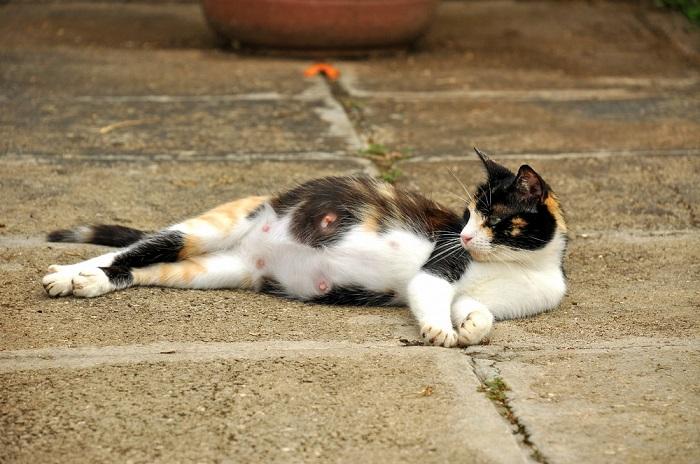
Depending on your cat’s size and hair coat, signs of pregnancy might be obvious or harder to detect.
The feline gestation period is around 63 to 67 days, but you can spot changes in early pregnancy before the litter arrives. If you have noticed changes to your cat’s nipples and wonder if she might be pregnant, consider these signs of a cat’s pregnancy to help you determine your pet’s situation.
Vomiting

Cats sometimes experience nausea and vomiting in early pregnancy just like people do.
Just as humans often experience morning sickness in pregnancy, vomiting can be an early sign of pregnancy in cats. Vomiting in pregnancy should be infrequent and intermittent. If your cat is sick often, or she seems otherwise unwell, seek advice from a veterinarian.
Also Read: 10 Subtle Signs Your Cat May Be Sick
Weight Gain

The more kittens a cat is carrying, the more weight she will gain.
You might notice abdominal swelling as your cat’s pregnancy progresses. Depending on the number of unborn kittens, pregnant cats gain about 2 to 4 pounds throughout the gestation. Be careful not to touch your cat’s abdomen, and don’t lift her with a hand under her tummy, as this might lead to pregnancy problems or pain.
Also Read: The 7 Best Cat Foods For Overweight Cats
Appetite

Pregnant cats need to eat more before the kittens are born and after the birth to support nursing.
Many pregnant queens have a markedly increased appetite in late pregnancy. This is due to the significant energy demand placed by the growing kittens and her changing body triggering her to eat more calories.
Also Read: Why Does My Cat Beg For Food?
Behavior Changes
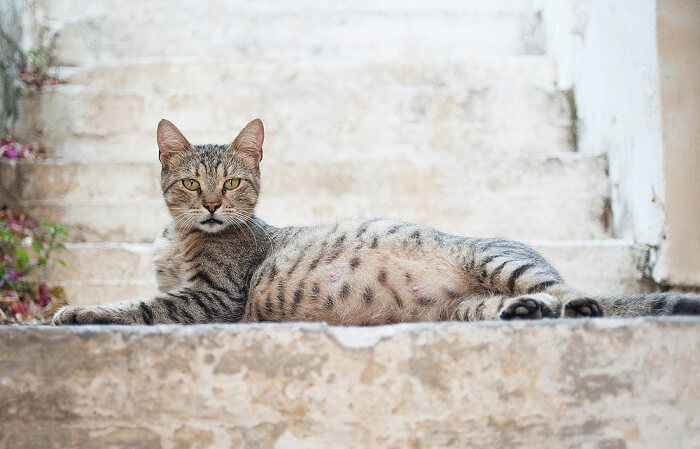
Some cats become more affectionate during pregnancy, but other might become aggressive.
Your cat might show some decided changes to their behavior and personality over the weeks of pregnancy. She might become more affectionate and cuddlier, and she might purr a lot. Conversely, a few pregnant cats become aggressive due to feeling very defensive about their unborn kittens.
Most cats will show nesting signs in the last two weeks of pregnancy. A pregnant cat might seek out a nesting area or two, such as a quiet corner behind the furniture, or even a suitable cardboard box. She might drag some soft blankets or towels into these nests. In very late pregnancy, just before labor, cats can show increased restlessness, vocalization, and hiding behaviors.
Also Read: Can Cats Sense Pregnancy?
What Should I Do If I Think My Cat Is Pregnant?
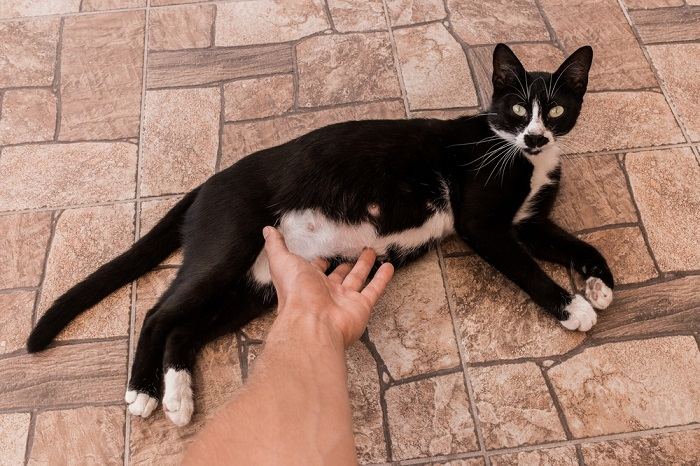
Schedule your cat for a veterinary checkup to find out for sure if she’s expecting and make sure her routine health care needs are met.
If the above signs of pregnancy are resonating with you as you observe your cat, then she might be pregnant. The best way to know with absolute certainty is to take her in for an ultrasound at your local veterinary clinic. This will give you a clear answer, and can even estimate the approximate number of kittens, although it can be tricky to get an exact number.
This is also a good opportunity to discuss routine care for your cat such as vaccines, and worm and flea treatment to make sure both she and the kittens are well protected and in the best health.
Also Read: Fostering A Pregnant Cat: What You Need To Know?
Other Causes of Nipple Changes
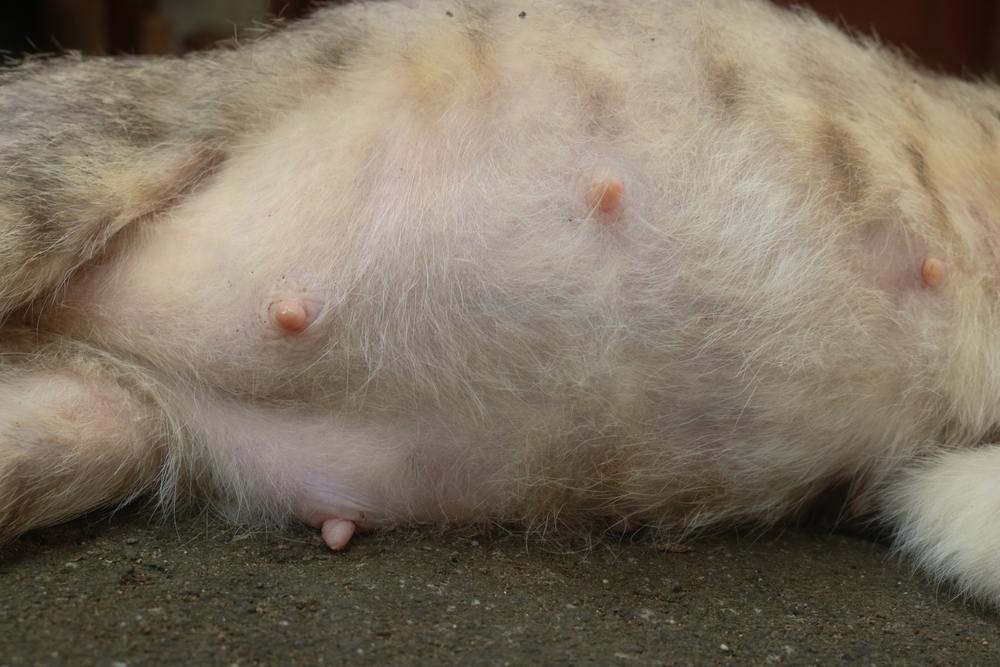
Nipple changes in a cat that is not pregnant can be caused by estrus, mastitis, or mammary cancer.
Nipple changes don’t necessarily mean that your cat is pregnant. Swollen pink nipples can merely indicate that your cat is in heat, and receptive to mating, rather than actually pregnant.
Some medical conditions can also cause nipple-related symptoms. Mastitis is the inflammation of a mammary gland, usually caused by a bacterial infection. It mostly occurs in nursing queens, as the kittens bite and knead at the nipples, causing small wounds which then allow bacteria to travel up into the milk glands.
Symptoms of mastitis include kittens not thriving and constantly hungry, fever and lethargy in the mother cat, red, swollen mammary glands, and discolored or cloudy milk. Mastitis is treatable with medications such as antibiotics and painkillers, but veterinary advice should be sought urgently if it is suspected as the kittens might need assistance feeding and the mother cat can become severely unwell if the problem is not treated.
Mammary cancer can also cause swelling to the mammary glands and nipple changes. Often a firm lump can be seen or felt on, around, or below the nipple. Other signs include depression and loss of appetite, discharge or bad smell around the glands, and ulceration. Mammary cancer in cats is usually diagnosed with a biopsy, and treated with surgery or possibly even chemotherapy.
Also Read: Cancer In Cats: Causes, Symptoms & Treatment
Preventing Pregnancy in Cats
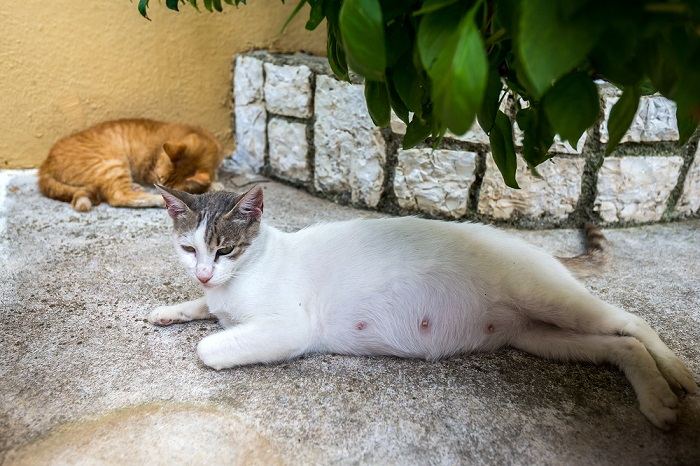
Spaying your cat offers heath and behavioral benefits, and prevents unwanted litters.
Kittens are just the cutest thing ever, but they also come with huge responsibility—and cost. If you have a female cat, bear in mind that they can become sexually mature from around 4 months old, and have multiple litters a year.
Spaying is a routine surgical procedure offered by veterinary clinics and has many benefits. Your cat won’t constantly come into heat, with all the associated behavioral changes that estrus brings. They won’t contribute to the overpopulation of cats, and spaying can reduce the risk of diseases such as mammary cancer. If you’d like to prevent pregnancy in your cat, talk to your veterinarian about having your cat spayed.
Also Read: How Much Does It Cost Spay or Neuter A Cat?
Final Thoughts
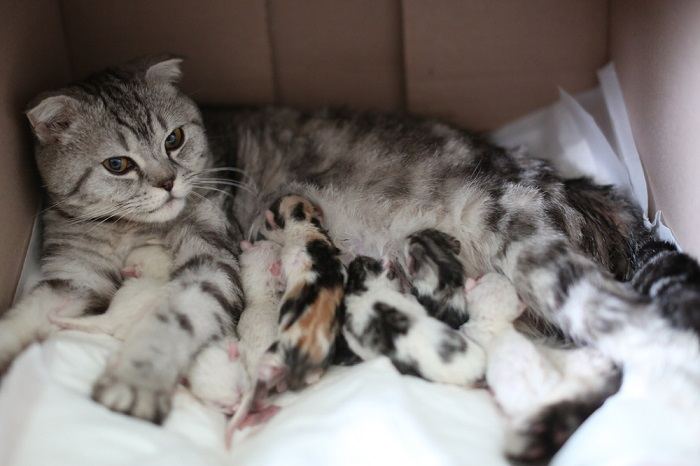
Cats have multiple pairs of nipples, but they are usually small, pale, and often covered in fur. During pregnancy, cats’ nipples get larger and darker in color and gain a ring of hairless skin around them. You might see other pregnancy changes such as weight gain, behavioral changes, nesting, vomiting, and appetite changes.
Cats also show changes to their nipples when in heat, but also with some medical conditions such as mastitis and mammary cancer. If you think your cat has nipple changes, seek veterinary advice to confirm pregnancy and to check for other health conditions.
Also Read: Cat Giving Birth: What You Need To Know?
Frequently Asked Questions
What does a cat’s belly feel like when pregnant?
Pregnant cats will have an enlarged abdomen when pregnant, which can feel distended and firm, especially in late pregnancy. It is not recommended to feel or touch a cat’s pregnant belly, as this might cause harm to the cat or kittens.
Can a cat have large nipples and not be pregnant?
Cats’ nipples enlarge when they are in heat, as well as when pregnant. They will remain large when nursing kittens after pregnancy and labor. There are also certain other conditions that can cause nipple changes, such as mastitis and mammary cancer.
How can you tell if a cat is pregnant?
In early pregnancy, a cat's nipples get large and red, and she might vomit a little. In later pregnancy, the belly will swell, and the cat will gain weight and might eat more. She will also show behavioral changes such as increased affection and nesting.
How big do cats’ nipples get when pregnant?
Around 15 to 18 days into pregnancy, a cat’s nipples will get redder and will double or even triple in size. Cat nipples also get big and dark when they are in heat.







